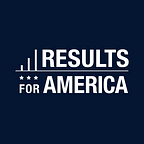Federal Evidence Frameworks: The Key to Enterprise-wide Evidence-Based Research and Funding Decisions
Invest in What Works Federal Standard of Excellence
Establishing a common evidence framework is an important step in developing an evidence-based culture. By using a common evidence framework, agencies are able to provide systematic, agency-wide assessments of their activities and advance the adoption of evidence-based programs as a routine practice. It lays the foundation for both agencies and their grantees to use evidence more effectively when making research, funding, and program decisions. The common evidence framework criteria in Results for America’s Invest in What Works Federal Standards of Excellence details how agencies can encourage an agency-wide adoption of evidence-based policymaking by:
6.1 Developing a common evidence framework for research and evaluation purposes
6.2 Using a common evidence framework for funding decisions
6.3 Maintaining a publicly available clearinghouse or other user-friendly tool to disseminate evaluation results and evidence-based solutions
6.4 Promoting the adoption and implementation of evidence-based solutions
Using established evidence frameworks to define, collect, and summarize research evidence can help scale, replicate, and adopt evidence-based practices to effectively advance the agency’s mission.
U.S. Department of Education
The U.S. Department of Education (ED) uses an agency-wide evidence framework, developed and maintained by the Institute for Education Science’s (IES) What Works ClearinghouseTM (WWC). The WWC is a user-friendly tool that allows grantees and other interested parties to access a searchable database containing over 10,650 studies categorized into ESSA evidence tiers. This information is made accessible to practitioners in 24 publicly available Practice Guides, which synthesize evaluation results and promote the adoption of evidence-based practices. ED’s Evidence Leadership Group has also coordinated the development of revised evidence definitions and related selection criteria for competitive programs that align with ESSA to streamline and clarify provisions for grantees. ED also produced a fact sheet to aid stakeholders in understanding the evidence definitions so they can most effectively use the information in the WWC or Practice Guides to implement evidence-based practices.
ED also uses the common evidence framework, further outlined in the Education Department General Administrative Regulations (EDGAR), to direct funds to discretionary grant applicants proposing to implement programs with evidence of effectiveness and/or to build new evidence.
U.S. Department of Labor
The U.S. Department of Labor, in addition to maintaining its Clearinghouse for Labor Evaluation and Research (CLEAR), collaborates with other agencies (U.S. Department of Health and Human Services (HHS), the U.S. Department of Education’s Institute of Education Sciences (IES), the National Science Foundation (NSF), and the AmeriCorps) to develop technological procedures to link and share reviews across clearinghouses.
DOL uses a number of user-friendly tools to widely distribute the results of their evaluation and promote the implementation of evidence-based programs. CLEAR’s study summaries and icons, found in each topic area, can help users quickly and easily understand what studies found and how much confidence to have in the results. The Employment & Training Administration (ETA) maintains Workforce System Strategies, a comprehensive database of over 1,000 profiles that summarize a wide range of findings to support program administration and promote state and local service providers’ use of evidence-based interventions. ETA also hosts a variety of learning communities to support grantees and practitioners in implementing evidence-based practices.
Administration for Children and Families
The HHS Administration for Children and Families (ACF) has established a common evidence framework adapted for the human services context from the framework for education research developed by the U.S. Department of Education and the National Science Foundation. ACF’s Office of Planning, Research, and Evaluation (OPRE) works to make evaluation results widely available and publicly accessible through multiple clearinghouses. OPRE research contracts include a standard clause requiring contractors to develop a dissemination plan during early project planning to identify key takeaways, target audiences, and strategies for most effectively reaching the target audiences. In addition, to further share learnings and research, OPRE also hosts two major conferences, the Research and Evaluation Conference on Self-Sufficiency (RECS) and the National Research Conference on Early Childhood (NRCEC) to share research findings with researchers and with program administrators and policymakers at all levels.
Common evidence frameworks are useful tools for both agencies and their grantees to build and use evidence in their programs. Investing in these common standards and resources, like clearinghouses, allows grantees to implement evidence-based practices. These resources will be invaluable to state and local government partners, who are encouraged to use evidence-based interventions and develop their own internal evaluation capacity with their American Rescue Plan Act funds, and provide a roadmap for agencies, grantees, and their partners to further develop their evaluation capacity and use evidence in their work.
